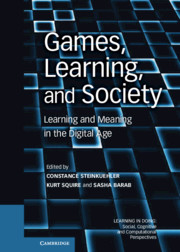Book contents
- Frontmatter
- Contents
- Contributors
- Series Foreword
- Foreword
- Acknowledgments
- Section I Games as Designed Experience
- Section II Games as Emergent Culture
- 10 Introduction to Section II
- 11 Nurturing Affinity Spaces and Game-Based Learning
- 12 Apprenticeship in Massively Multiplayer Online Games
- 13 Theorycrafting
- 14 Culture and Community in a Virtual World for Young Children
- 15 Culture versus Architecture
- 16 Participatory Media Spaces
- Section III Games as Twenty-First-Century Curriculum
- Index
- References
15 - Culture versus Architecture
Second Life, Sociality, and the Human
Published online by Cambridge University Press: 05 August 2012
- Frontmatter
- Contents
- Contributors
- Series Foreword
- Foreword
- Acknowledgments
- Section I Games as Designed Experience
- Section II Games as Emergent Culture
- 10 Introduction to Section II
- 11 Nurturing Affinity Spaces and Game-Based Learning
- 12 Apprenticeship in Massively Multiplayer Online Games
- 13 Theorycrafting
- 14 Culture and Community in a Virtual World for Young Children
- 15 Culture versus Architecture
- 16 Participatory Media Spaces
- Section III Games as Twenty-First-Century Curriculum
- Index
- References
Summary
While the emergence of virtual worlds as viable sites for the generation of economic value and exchange has been central to their broader acceptance as domains where real stakes accumulate (Malaby, 2006a), their capacity as sites for the generation of social ties and for learning – fundamental forms of social exchange beyond the market – has received secondary interest outside of a few forward-thinking disciplines. Second Life has demonstrated a substantial such capacity and saw a great amount of growth in both educational use and sociality more generally since its appearance in 2003. That is, Second Life’s users accumulated both social capital within the world through the reciprocal cultivation of social ties and cultural capital in the form of competencies as a result of learning within the world, whether formally or informally.
Such success makes it perhaps too easy to assume that Second Life’s design – its architecture – presupposed such use and supported it in a thoroughgoing manner. Remarkably, however, the rise of social and cultural capital within Second Life has happened in many respects despite Second Life’s architecture. In this chapter I argue that Second Life was built in fundamental ways on an asocial imagining of the human, one grounded in a technoliberal sensibility. On this view, human beings are resolutely individuals, at root motivated by the challenge to act within and gain mastery of complex and open-ended systems (not coincidentally, this is also a construction of a specific kind of gamer). Correspondingly, social effects (the creation of exclusionary groups, lobbying and other political activity, and others) are ideally at best minimized or at worst excluded by system design, an issue that I have explored at length in the context of Linden Lab’s internal decision making (Malaby, 2009a). The imagined user of Second Life was in many respects not supposed to be social except in a very narrow sense, and this raised a number of challenges for users of Second Life as well as for the employees of Linden Lab (Lindens), who struggled to support the emergent uses of the world that challenged their expectations. I suggest that this has important implications for the kinds of learning that are architecturally recognized within Second Life, even if in practice users to a certain extent can transcend these promptings and achieve learning in the social and collaborative sense.
- Type
- Chapter
- Information
- Games, Learning, and SocietyLearning and Meaning in the Digital Age, pp. 229 - 243Publisher: Cambridge University PressPrint publication year: 2012



